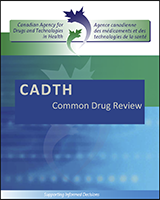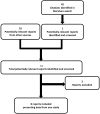1.4.1. Description of study
The GRIPHON study, a double-blind, event-driven, placebo-controlled, group-sequential trial, met the inclusion criteria and is summarized in . The primary objective of the study was to demonstrate the effect of selexipag on time to first primary outcome event in patients with PAH. The duration of the study depended on the occurrence of the primary outcome events. Patients were randomized 1:1 to selexipag or placebo via a central randomization system. Randomization was stratified by site. A block size of four was used. Identical placebo was used and the investigator and study staff, patients, monitors, and sponsor were blinded to the treatment.
1.4.3. Interventions
The initial dose of selexipag was 200 mcg twice daily. If this was well tolerated, the dose was increased by weekly increments of 200 mcg until 1,600 mcg twice daily was reached at week 12. If the patient experienced adverse events known to be associated with IP receptor agonists, such as headache, diarrhea, jaw pain, myalgia, flushing, and nausea, the dose could be maintained or reduced and the adjusted dose was to be defined as the maximum tolerated dose. At week 12, the maximum tolerated dose for each patient was determined, and this dose was to be kept stable for the next 14 weeks, up to the week 26 assessment of the secondary end point, change in 6MWD. After week 26, for patients with study drug dose < 1,600 mcg twice daily, investigators were allowed to further up-titrate the dose, if needed, by 200 mcg increments up to the maximum of 1,600 mcg twice daily, if the investigator identified a tolerability concern for a patient. The investigators could discontinue study treatment at their discretion.8
Of the selexipag-treated patients, 28% received a selexipag maintenance dose of 1,600 mcg twice daily (; i.e., the maximum selexipag dose allowed in the study) and in the placebo group, the highest number of tablets corresponding to the 1,600 mcg twice daily dose was achieved by 68% of patients. In 14 patients taking selexipag (2%), the selexipag maintenance dose was set to 0 (i.e., patients who received only the initial selexipag 200 mcg dose during the titration period and discontinued at this dose).
Maintenance Dose of Selexipag in the Selexipag Treatment Group in Griphon.
Concomitant therapy protocol rules in the GRIPHON study
Concomitant ERAs and/or PDE5 inhibitors were allowed if patients had been on a stable dose for at least three months prior to baseline. The dose was to remain unchanged during study treatment up to week 26. Diuretics were permitted. Introduction of any new treatment for PAH (or increase in dose) without a morbidity or mortality event confirmed by the Critical Event Committee (CEC) was permitted but discouraged. Concomitant administration of prostacyclin (epoprostenol) or prostacyclin analogues (i.e., treprostinil, iloprost, beraprost) was not permitted according to the study protocol.
Concomitant therapy for pulmonary arterial hypertension at baseline
There were differences in concomitant therapy at baseline across geographical groups. In an analysis by geographical region, ▬ of patients in the selexipag and placebo groups in the geographical regions of North America, Western Europe, and Australia, including Israel and Latin America, were receiving a PAHspecific medication at baseline compared with approximately ▬ in Asia and ▬ in Eastern Europe, including Turkey. Most of the patients in North America (▬ and Western Europe and Australia, including Israel (▬ were receiving treatment with two PAH-specific therapies. Sildenafil was the most frequently reported PDE5 inhibitor used as monotherapy in ▬ ▬.8
Concomitant therapy for pulmonary arterial hypertension while on study drug
In spite of the protocol guidelines, ▬ of patients in the selexipag group and ▬ in the placebo group started treatment with a PAH-specific medication while on study drug.8 Treatment with two PAH-specific therapies (an ERA and a PDE5 inhibitor) was initiated for ▬▬▬ of patients in the selexipag and placebo groups, respectively, with bosentan and sildenafil the most frequently reported ERA and PDE5 inhibitor combination (▬).
The proportion of patients who started treatment with a PDE5 inhibitor (monotherapy) while on study drug was ▬ in the selexipag group compared with ▬ in the placebo group, with sildenafil reported for ▬ patients in the selexipag group and ▬ in the placebo group. A total of ▬ patients in the selexipag group and ▬ the placebo group started treatment with an ERA (monotherapy) while on study drug, with bosentan reported for ▬ patients in the selexipag group and ▬ the placebo group.
Initiation of treatment with a prostacyclin or prostacyclin analogue while on study drug was reported for ▬ patients in the selexipag group and ▬ the placebo group. The proportion of patients who started treatment with epoprostenol was ▬ the selexipag group and ▬ the placebo group.
The proportion of patients who started treatment with at least one PAH-nonspecific medication while on study drug was ▬▬▬▬▬ in the selexipag and placebo groups, respectively. Diuretics (e.g., furosemide, spironolactone) were the most frequently reported medications in both groups (▬▬▬▬▬). The proportions of patients who concomitantly received oxygen were ▬▬▬ the selexipag group and ▬▬ the placebo group, calcium channel blockers (▬▬▬▬▬).
PAH medication started after study drug discontinuation
In response to a request for additional information (June 30, 2016), the manufacturer stated that PAH-specific medication that was initiated after study drug discontinuation, before the end of the study, occurred ▬ patients in the selexipag group and ▬ patients in the placebo group.


